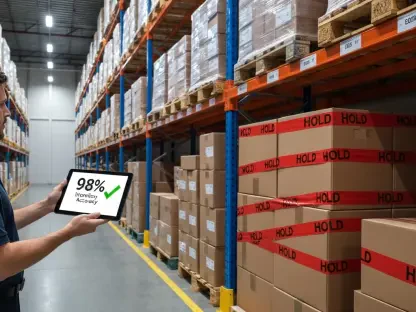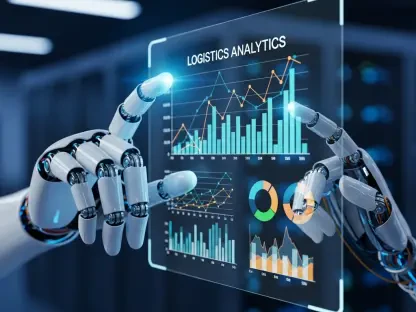The article delves into the pivotal role of e-commerce logistics in managing the flow of goods from manufacturers to customers in the digital shopping era. As online shopping grows, the importance of e-commerce logistics is magnified, encompassing critical steps like warehousing, inventory management, order processing, and shipping. The sector has become increasingly sophisticated, integrating advanced technologies to meet the rapid pace and high standards of consumer expectations.
Market Growth and Regional Dominance
Global Market Expansion
Global market expansion has become increasingly vital for businesses seeking sustainable growth and diversification. Companies must carefully consider cultural differences, local regulations, and market demands to successfully enter new markets. Effective expansion strategies often involve partnerships, joint ventures, and localized marketing efforts. By navigating these complexities, businesses can unlock new opportunities and achieve long-term success in the global arena.
The global e-commerce logistics market is predicted to expand from USD 412.5 billion in 2023 to an impressive USD 1698.0 billion by 2033, representing a compound annual growth rate (CAGR) of 15.2% from 2024 to 2033. This significant growth underscores the increasing reliance on efficient logistics solutions to support the booming e-commerce industry. The rapid expansion is driven by rising consumer expectations for quicker delivery times and the global expansion of e-commerce sales. As more consumers embrace online shopping, businesses must keep pace with evolving logistics demands to ensure seamless supply chain operations, meeting the heightened standards of modern consumers.
Efficient logistics are the backbone of the e-commerce industry, ensuring products are delivered swiftly and in perfect condition. To support this growing demand for efficient logistics, companies are investing heavily in technology and infrastructure. The integration of advanced technologies, such as artificial intelligence and machine learning, is crucial in optimizing logistics processes, improving order accuracy, and reducing delivery times. Furthermore, the adoption of automation and robotics in warehouses enhances operational efficiency, enabling companies to handle larger volumes of orders seamlessly. Strong logistics networks are vital to sustaining the anticipated market growth, positioning businesses to cater effectively to an increasingly discerning consumer base.
Asia Pacific’s Leading Role
In 2023, the Asia Pacific region emerged as a leader, accounting for over 35% of the global market share, equating to USD 144.3 billion in revenue. This highlights the region’s significant role in driving market growth. Countries like China and India are at the forefront, with extensive logistics infrastructure developments and a high volume of online shoppers. The region’s dominance is expected to continue, fueled by ongoing investments in logistics technology and infrastructure. Robust e-commerce growth in these countries is attributed to a burgeoning middle class, increased internet penetration, and a tech-savvy population eager to embrace online shopping.
Governments and private enterprises throughout the Asia Pacific are heavily invested in logistics infrastructure to support the burgeoning e-commerce sector. These investments are evident in the creation of smart warehouses, advanced transportation networks, and the integration of cutting-edge technologies. As a result, logistics providers can offer quicker delivery times and more efficient services. The development of dedicated logistics parks and the enhancement of last-mile delivery solutions are also propelling the region forward. These efforts, combined with a strong focus on customer satisfaction, solidify Asia Pacific’s position as a global leader in the e-commerce logistics space.
Driving Forces and Market Trends
Rising Consumer Expectations
The e-commerce logistics market is driven by rising consumer expectations for quicker delivery times and the global expansion of e-commerce sales. Businesses are continually innovating and optimizing their logistics strategies to meet the need for efficient order fulfillment and delivery services. The increase in cross-border e-commerce transactions pushes companies to enhance their international logistics operations. Customers now demand same-day or next-day delivery options and seamless tracking capabilities, pressuring businesses to refine their logistics systems to maintain competitive advantages and satisfy customer expectations.
To meet these expectations, companies are leveraging advanced technologies such as AI-driven demand forecasting and automated warehouse systems. These technologies enable businesses to predict customer needs accurately and manage inventory more effectively, reducing the risk of stockouts or overstocking. Additionally, sophisticated routing algorithms optimize delivery routes, ensuring timely deliveries even during peak shopping seasons. Enhanced logistics infrastructure, including strategically located micro-fulfillment centers, plays a critical role in achieving faster delivery times. By continually refining their logistics processes, companies can keep pace with evolving customer demands and drive growth in the competitive e-commerce market.
Investments in Logistics Infrastructure
High consumer demand for fast and reliable services has led to significant investments in logistics infrastructure, such as the development of micro-fulfillment centers and last-mile delivery solutions. These investments are crucial for meeting the growing demand for rapid and efficient delivery services, particularly in urban areas where quick delivery is a key competitive advantage. Companies are strategically placing fulfillment centers closer to major population centers, reducing transit times and enhancing delivery capabilities. The focus on last-mile delivery solutions, such as automated delivery lockers and drone deliveries, addresses the critical challenge of delivering packages swiftly and efficiently in densely populated areas.
Moreover, the integration of advanced technologies within logistics infrastructure boosts operational efficiencies and reduces costs. Automation in warehousing and transportation networks allows for seamless coordination and real-time tracking of shipments, ensuring transparency and reliability in the delivery process. Investment in sustainable logistics practices, such as electric delivery vehicles and eco-friendly packaging, also aligns with increasing consumer demand for environmentally conscious options. By investing in state-of-the-art logistics infrastructure, companies can stay competitive in the rapidly evolving e-commerce landscape, ensuring they can meet and exceed customer expectations.
Opportunities in the E-commerce Logistics Sector
The rapid growth of the e-commerce industry has created a myriad of opportunities in the logistics sector. As more consumers turn to online shopping, the demand for efficient and reliable delivery services has surged. This shift has spurred innovation in last-mile delivery solutions, warehousing, and supply chain management. Companies that can provide streamlined operations and adapt to changing consumer expectations are poised to capitalize on this burgeoning market. Additionally, advances in technology, such as automation and AI, are reshaping the logistics landscape, offering new ways to enhance efficiency and meet the high demands of e-commerce.
Last-Mile Delivery and Reverse Logistics
Several opportunities exist within the e-commerce logistics sector, especially in last-mile delivery, reverse logistics, and sustainability practices. Expanding into new geographic markets presents lucrative opportunities for logistics providers. There is also a growing emphasis on reaching consumers in remote or less accessible areas, which requires innovative delivery solutions. Technologies such as autonomous delivery vehicles and drone deliveries offer promising solutions for last-mile delivery, significantly reducing costs and improving delivery times in hard-to-reach locations.
Reverse logistics, the process of managing returns, is another area with significant growth potential. Efficiently handling returns and exchanges is crucial for maintaining customer satisfaction and loyalty. Companies are implementing advanced tracking systems and automated processes to streamline reverse logistics, ensuring timely and accurate processing of returns. This not only enhances the customer experience but also reduces operational costs associated with returns handling. By capitalizing on these opportunities, businesses can strengthen their logistics capabilities, extending their reach and improving service quality in the competitive e-commerce landscape.
Sustainability Practices
Integrating eco-friendly practices and technologies is opening new avenues for companies aiming to enhance their sustainability credentials while meeting consumer demands. Sustainable packaging, optimized delivery routes to reduce carbon emissions, and deploying electric vehicles for transportation are some of the initiatives being adopted to create a greener logistics ecosystem. Consumers are increasingly prioritizing sustainability in their purchasing decisions, prompting businesses to adopt environmentally friendly logistics practices. Implementing green logistics solutions not only meets customer expectations but also contributes to long-term environmental goals.
Companies are also exploring renewable energy sources for powering logistics operations and warehouses. Utilizing solar panels and other renewable energy sources reduces dependency on conventional energy and minimizes carbon footprints. Additionally, collaborating with eco-friendly partners and incorporating sustainable materials in packaging further reinforces corporate social responsibility commitments. These initiatives align with global sustainability trends and regulatory requirements, positioning businesses as responsible and forward-thinking leaders in the e-commerce logistics sector. By adopting and promoting sustainable logistics practices, companies can gain a competitive edge and build stronger, more sustainable customer relationships.
Technological Innovations
AI and Machine Learning
Technological innovation plays a crucial role in the evolving e-commerce logistics landscape. The adoption of artificial intelligence (AI) and machine learning (ML) is revolutionizing demand forecasting, inventory management, and delivery route optimization. These technologies facilitate faster and more accurate order processing and enhance the overall customer experience by providing real-time updates and improving delivery service reliability. By leveraging AI and ML, companies can predict demand patterns with greater precision, ensuring they have the right products in stock when needed.
AI also plays a significant role in optimizing delivery routes and reducing transportation costs. Machine learning algorithms analyze traffic patterns, weather conditions, and other variables to identify the most efficient delivery routes. This not only speeds up delivery times but also minimizes fuel consumption and reduces carbon emissions. Furthermore, AI-powered chatbots and virtual assistants enhance customer service by addressing inquiries promptly and accurately, freeing up human resources for more complex tasks. The integration of AI and ML in e-commerce logistics fosters a seamless, efficient, and customer-centric supply chain, driving growth and competitive advantage for businesses.
Automation in Warehousing
Automation in warehousing and sophisticated order management systems improve operational efficiencies and reduce costs. Automated systems for picking, packing, and sorting orders increase processing speed and accuracy, allowing businesses to handle larger volumes of orders with greater efficiency. This is particularly important during peak shopping seasons when order volumes surge. Warehouse automation includes the use of robotic arms, conveyor belts, and automated guided vehicles (AGVs) to streamline order fulfillment processes, ensuring quick and error-free operations.
Sophisticated order management systems integrate seamlessly with warehouse automation, providing real-time inventory visibility and enabling efficient stock management. This integration ensures that businesses can track inventory levels accurately, reducing the risk of stockouts and overstocking. Automated systems also enhance scalability, allowing companies to expand their operations without significant increases in labor costs. By embracing warehouse automation, businesses can achieve higher operational efficiency, reduce costs, and improve the overall customer experience, maintaining a competitive edge in the rapidly evolving e-commerce sector.
E-commerce Logistics Statistics
Dominant Logistics Type
Forward logistics dominated the market, holding a 69% share. This segment is crucial in managing the flow of goods from production to consumption, meeting the high demand for efficient order fulfillment and delivery services. The focus on forward logistics highlights the importance of streamlined processes to ensure timely and accurate deliveries. Efficient forward logistics systems are essential for maintaining product quality and customer satisfaction, particularly in a competitive e-commerce environment where quick and reliable deliveries are vital.
Implementing advanced technologies and data analytics in forward logistics enhances visibility and control over the supply chain, allowing businesses to anticipate and mitigate potential disruptions. This ensures smooth operations from the point of production to the final consumer. Forward logistics also encompasses the transportation and handling of goods, making it crucial for maintaining end-to-end efficiency in the supply chain. By prioritizing forward logistics, companies can optimize their operations, reduce costs, and enhance service quality, ensuring they meet the ever-increasing demands of their customers.
Service Breakdown
Our comprehensive service breakdown ensures that every aspect of our offerings is clearly outlined and easily understood. We start by providing a detailed analysis of each service, highlighting its unique features and benefits. Next, we outline the specific steps involved in delivering the service, including timelines and key milestones. This is followed by a breakdown of costs, ensuring transparency and helping clients make informed decisions. Finally, we offer a summary of our customer support options, ensuring clients know how to get assistance when needed.
Transportation emerged as the most critical service within e-commerce logistics, accounting for 70% of the market share. It highlights the importance of fast, flexible, and reliable delivery options to meet growing customer expectations. Efficient transportation networks are essential for maintaining the speed and reliability of e-commerce deliveries. Companies are investing in advanced transportation technologies, including real-time tracking systems and route optimization software, to enhance the efficiency and reliability of their delivery services.
The significance of transportation in e-commerce logistics is underscored by the need for timely deliveries. Delays in transportation can lead to customer dissatisfaction and loss of business. Therefore, logistics providers focus on optimizing their transportation networks to ensure quick and dependable delivery services. The use of autonomous vehicles and drones for last-mile delivery is also gaining traction, offering innovative solutions to improve delivery speed and reduce operational costs. By prioritizing efficient transportation services, e-commerce businesses can enhance their logistics capabilities, meet customer demands, and stay competitive in the market.
Business Model Preference
The Third-Party Logistics (3PL) model was preferred by the majority, with a 76% market share. E-commerce companies are increasingly outsourcing to 3PL providers for cost efficiencies and scalability, allowing them to focus on core business areas. This trend is expected to continue as businesses seek to optimize their logistics operations without significant capital investment. 3PL providers offer expertise in logistics management, advanced technology solutions, and extensive distribution networks, providing e-commerce companies with comprehensive and efficient logistics services.
Outsourcing logistics to 3PL providers allows e-commerce businesses to benefit from economies of scale, reducing overall logistics costs and improving service quality. 3PL providers can leverage their resources and expertise to streamline operations, manage inventory effectively, and ensure timely deliveries. Additionally, the flexibility offered by 3PL services enables businesses to scale their operations quickly in response to market demands, ensuring they can meet fluctuating order volumes without compromising service quality. By adopting the 3PL model, e-commerce companies can enhance their logistics capabilities, reduce costs, and focus on core business activities, driving overall growth and success.
Impact of AI on E-commerce Logistics
AI is revolutionizing the e-commerce logistics industry by optimizing various operational aspects, leading to increased efficiency and customer satisfaction. By utilizing advanced algorithms and machine learning techniques, companies can predict demand more accurately, manage inventory better, and improve delivery routes, resulting in faster and more reliable service for consumers.
Warehouse Operations Optimization
The impact of AI on e-commerce logistics is immense, enhancing various operational aspects to create more efficient and responsive systems. This includes optimizing warehouse operations with advanced management systems, refining order fulfillment processes, and improving route optimization and real-time tracking. AI-driven systems enable better inventory management and faster order processing, leading to improved customer satisfaction. Advanced AI algorithms analyze historical data, predicting demand patterns and ensuring optimal inventory levels, reducing the risk of stockouts and overstocking.
AI-powered solutions also enhance warehouse automation, improving the efficiency of picking, packing, and sorting operations. Robotic systems and automated guided vehicles (AGVs) work in harmony with AI-driven management systems to streamline order fulfillment processes, minimizing errors and speeding up operations. The integration of AI in warehouse operations not only boosts efficiency but also reduces operational costs, allowing businesses to handle higher order volumes without significantly increasing labor costs. By leveraging AI in warehouse operations, e-commerce companies can achieve greater operational efficiency, improve service quality, and enhance the overall customer experience.
Predictive Maintenance and Customer Service
AI facilitates predictive maintenance, enabling businesses to proactively address equipment issues before they result in operational disruptions. Using AI algorithms to analyze machine performance data, companies can predict potential failures and schedule maintenance activities during non-peak times, ensuring uninterrupted operations. This predictive approach reduces downtime, extends the lifespan of equipment, and optimizes overall productivity. By adopting AI-driven predictive maintenance, logistics providers can maintain smooth and efficient operations, minimizing the risk of delays and ensuring reliable service delivery.
In addition to improving maintenance processes, AI also enhances customer service through AI-powered tools like chatbots and virtual assistants. These tools provide quick and accurate responses to customer inquiries, offering real-time updates on order status and delivery times. AI-driven customer service solutions free up human agents to handle more complex tasks, improving overall efficiency and customer satisfaction. By leveraging AI for both predictive maintenance and customer service, e-commerce companies can optimize their operations, reduce costs, and provide a superior customer experience, strengthening their competitive position in the market.
Conclusion
The article explores the critical role of e-commerce logistics in efficiently managing the movement of products from manufacturers to customers in the age of online shopping. As the popularity of online shopping skyrockets, the significance of e-commerce logistics cannot be overstated. This field encompasses key processes such as warehousing, inventory management, order processing, and shipping. The demands of today’s consumers, who expect rapid delivery and high service standards, have driven the evolution of e-commerce logistics into a highly sophisticated sector. This transformation is characterized by the integration of cutting-edge technologies designed to enhance operational efficiency.
Technological advancements like automation, AI-driven analytics, and real-time tracking systems have revolutionized how e-commerce logistics functions. Automation speeds up warehousing and inventory management, while AI helps optimize order processing. Real-time tracking provides customers with up-to-the-minute updates on their shipments, further elevating their shopping experience. Companies must continuously innovate and adapt to maintain a competitive edge in this fast-paced environment.
Overall, e-commerce logistics is a cornerstone of the digital shopping ecosystem, ensuring that goods are delivered swiftly and accurately, meeting the high expectations of modern consumers. As online shopping continues to thrive, the importance of effective logistics will only grow, making it an essential aspect of e-commerce success.









